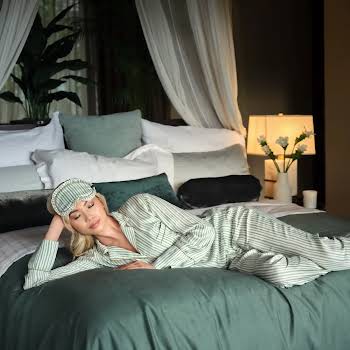
By Amanda Cassidy
12th Jul 2019
12th Jul 2019
We all get anxious, but for around 7% of us, anxiety can become chronic and lead to panic attacks. Amanda Cassidy looks at why our worries are spiralling, and how to get anxiety attacks under control.
“For me, my trigger was driving. Out of nowhere, my palms would get sweaty and I’d know it was coming, which made me even more panicky. My heart would feel like it was beating out of my chest and I had a sense of terror and dread that you can’t even describe. It was particularly hard with the children in the car because I was trying to stay calm for them but internally, I was all over the place. The attacks became more and more frequent and I began to avoid going out. I was a prisoner of my mind and my body.”
Related: Tips to help anxiety sufferers
Mum of two, Denise suffered panic attacks in her 20s after a serious car accident. She thought she’d overcome them with breathing exercises until they returned after the birth of her son. “I was terrified of the world and fear ruled my life. I think they came back because I felt so vulnerable. Once they hit, I’d have to remind myself over and over again that I wasn’t dying or losing my mind. It is just horrible.”
Stigma
Anxiety is one of the biggest health problems facing Ireland today – but even though one in 13 of us suffers from clinical anxiety, it remains a taboo. The stigma attached to admitting you have acute anxiety, coupled with an under-funded mental health service has given rise to a silent epidemic. Research carried out by the Psychiatric Epidemiology Research across the Lifespan Group, found that approximately one in eight adolescents had experienced an anxiety disorder, and by the age of 24 one in four of us had experienced either a mood or an anxiety disorder. Of particular concern is the increasing number of women in their 30s and 40s presenting to their GP with anxiety and stress. The concern too is that this group are largely self-medicating with a nightly glass or two of wine which can lead to further problems.
But many don’t even know how to define this feeling of terror. Some describe it as thinking they are going mad or that they have legitimate heart problems.
A panic attack is a powerful and unexplainable sense of terror that comes on without warning. It triggers severe physical reactions, despite there being no real danger or apparent cause, including heart palpitations, dizziness, headache and shortness of breath.
While the attacks are almost twice as likely to affect women, experts estimate that more than a quarter of all people will experience a panic attack, while one in nine Irish people will experience a primary anxiety disorder during their lifetime.
“Terrifying”
Emily is 34. As her anxiety got worse, she began to isolate herself even more. “Every morning, I’d wake up with an overwhelming fear that I’d either die or lose somebody else. It was paralysing. Getting out of bed was terrifying. It felt like there was too much to overcome, too many people to talk to, and before the day even started, I’d decided it was just too exhausting. I was stressing myself out but for seemingly no real reason. I didn’t want to risk having an attack if I was out in public so I stayed in, alone.”
Eventually, Emily’s family members encouraged her to try CBT or cognitive behavioural therapy. This is based around the theory that our thoughts influence our emotions, which influence our behaviour. By learning simple techniques, Emily was able to rewire some of her perspectives. She discovered that it is not what happens to us in life that causes us distress, rather how we interpret it. “Some of my beliefs were very irrational. By rowing back and asking myself if what I believed to be true, was real or not, it allowed me to get some perspective.”
Bestselling Irish author, Dr Harry Barry has spent years researching stress and anxiety. He says that to understand a panic attack we need to know exactly what is going on physically, in order to face it down. “Not many people realise that the physical symptoms experienced by the person are created by an adrenaline rush. This occurs when our stress system is activated by the amygdala (a part of our brain that responds to danger), or gunslinger, firing inadvertently and seemingly without warning. This floods the body with adrenaline, often without distinguishing between life-threatening events and minor stressors.
The why
In appropriate situations, high levels of anxiety are considered helpful and allow us to escape from danger. The problems arise when our response is at odds to the actual danger of the situation, or when it is generated when there is no danger present. Unfortunately, this part of our brain does not respond to regular talk therapies or logic which is why he says an effective way of dealing with the issue is through ‘flooding’. In his book, Emotional Resilience: How to safeguard your mental health (a book that every parent should read) he describes how to practice ‘flooding’ – a way of tackling the issue face on.
“Accept that a typical adrenaline rush is only going to last five to eight minutes”.
Accept and brace
“Never try to stop the physical symptoms of general anxiety. This only causes them to become more pronounced. Visualise in your mind that you are stuck to the floor or seat and unable to move. Allow the uncomfortable physical symptoms to wash over you like a wave, without trying to stop them. Do not apply any safety behaviours to try to stop these physical symptoms – just go with them.
Accept that a typical adrenaline rush is only going to last five to eight minutes. Adapt the philosophy of ‘bring it on’ in relation to these uncomfortable physical symptoms. Accept that these physical symptoms are uncomfortable but not dangerous.
You are only allowed to move when the symptoms have subsided.” Dr Barry says that you only really need to apply this technique four or five times before the acute physical symptoms start to fade. “It is the function of your stress system to keep you safe and not harm you. So it is really the discomfort you are desperate to avoid.
Flooding
Eventually, as you apply this ‘flooding’ experiencing but accepting the uncomfortable physical symptoms of anxiety, the amygdala changes its memory. It recognises you are no longer assigning danger to these symptoms but instead just going with them. Since its job is to sense danger and it is no longer picking danger up, it quickly shuts down the adrenaline rush. The physical symptoms cease and the gunslinger recalibrates its memory for future similar episodes. In other words, it turns the dial down.”
Why we suffer from anxiety or not depends largely on our upbringing, our lived experiences and the social world around us. Dr Barry says the pressure of perfection is producing a generation beset by anxiety and panic attacks. “We are comparing ourselves to others and trying to match the virtual world with the experience in real life. So much of our interactions are based around needing to be liked and rated. Our lives are consumed with it and it certainly doesn’t help our inherent insecurities.“
Emily has also found solace in practising mindfulness which helps her to overcome her anxiety. She uses a technique called ‘grounding’ which encourages an awareness of surroundings and to live in the moment. “I make myself notice things around me, “The clouds are fluffy. I hear a bird singing. My seat is soft. I find it helpful to drown out the irrational thoughts: There are so many people. I can’t breathe. I’m stuck. That is the thing about panic attacks. They come, and they go. It feels like the whole world crashes in on you. It is scary, but it always passes. I survive and life keeps moving forward”
Image via Unsplash.com
Read more: Emma Stone on panic attacks
Read more: Social anxiety – a survival guide
Read more: The description of depression by Jim Carey will stop you in your tracks





















